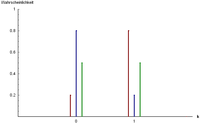Bernoulli distribution

Imagine you have a magical coin that has a special power. When you flip it, you have a 50/50 chance of getting heads or tails.
Now, let's say you flip this coin 10 times in a row. You might get 5 heads and 5 tails, since it's a fair coin. But what if you flipped it 100 times in a row? or 1000 times? It's possible that you might get more tails than heads, or vice versa.
The Bernoulli distribution is a tool that helps us understand the probability of getting a certain number of heads (or tails) when we flip a magical coin a certain number of times. It's named after a famous mathematician named Bernoulli, who studied this problem a long time ago.
To use the Bernoulli distribution, we need to know two things: the probability of getting heads (let's call that p), and the number of coin flips we want to consider (let's call that n). Using this information, we can calculate the probability of getting a certain number of heads when we flip the coin n times.
For example, let's say we flip our magical coin 10 times, and we know that the probability of getting heads is 0.5 (since it's a fair coin). Using the Bernoulli distribution, we can calculate the probability of getting 5 heads (and 5 tails). It turns out that this probability is about 0.25, or 25%.
We can use the Bernoulli distribution for lots of different problems, not just magical coins. For example, we might use it to understand the probability of getting a certain number of correct answers on a multiple choice test, or the probability of winning a game of chance like roulette.
So in summary, the Bernoulli distribution is a way of understanding the probability of getting a certain number of successes (like heads on a coin flip) when we repeat an experiment a certain number of times. It helps us make predictions about the future based on what we know about the past.
Now, let's say you flip this coin 10 times in a row. You might get 5 heads and 5 tails, since it's a fair coin. But what if you flipped it 100 times in a row? or 1000 times? It's possible that you might get more tails than heads, or vice versa.
The Bernoulli distribution is a tool that helps us understand the probability of getting a certain number of heads (or tails) when we flip a magical coin a certain number of times. It's named after a famous mathematician named Bernoulli, who studied this problem a long time ago.
To use the Bernoulli distribution, we need to know two things: the probability of getting heads (let's call that p), and the number of coin flips we want to consider (let's call that n). Using this information, we can calculate the probability of getting a certain number of heads when we flip the coin n times.
For example, let's say we flip our magical coin 10 times, and we know that the probability of getting heads is 0.5 (since it's a fair coin). Using the Bernoulli distribution, we can calculate the probability of getting 5 heads (and 5 tails). It turns out that this probability is about 0.25, or 25%.
We can use the Bernoulli distribution for lots of different problems, not just magical coins. For example, we might use it to understand the probability of getting a certain number of correct answers on a multiple choice test, or the probability of winning a game of chance like roulette.
So in summary, the Bernoulli distribution is a way of understanding the probability of getting a certain number of successes (like heads on a coin flip) when we repeat an experiment a certain number of times. It helps us make predictions about the future based on what we know about the past.
Related topics others have asked about:
